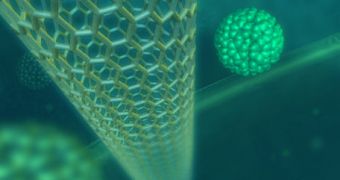The device built at the University of Michigan could revolutionize the understanding of the processes that take place inside living cells, and may bring valuable insight on how or why certain cells grow without control, and damage nerves.
The device has a spherical shape, is about 30 nanometers in diameter, and compared to the currently existing voltmeters is about 1,000 time smaller; also, unlike other electronic devices which need constant power to work, it is powered by light. This could be probably used to probe the electrical fields inside a living cell, and measure the voltage of the surrounding cells, but not the one inside the cell.
The measuring technique involves a rather new approach, and while the traditional way to measure a voltage needs only a single voltmeter, the new device will be deployed in numbers that could count up to a thousands nanovoltmeters at the same time, which would disperse inside a single cell. They work on the basis of a voltage-sensitive dye, which when stimulated with a light beam of wavelength corresponding to the blue color, it reacts by emitting back light in the red and green domain, the ratio between the two colors indicating the strength of the electric field in the area where the nanovolmeter is located.
Preliminary tests, made by using this new device, show that the electric field in the material inside the cell is higher than previously thought. The previous theory, regarding the electric field inside the cytosol, predicted that it should be somewhere close to zero, but as 13 separate regions were probed, the nanovoltmeters indicated a value of about 15 million volts per meter; compared to the strength of the electrical field inside closed spaces, such as our home, it is usually between five to ten volts per meter, and under a power cable it can reach up to 10,000 volts per meter.
The discovery of such a powerful electric field inside living cells came as a shock for scientists studying this domain.
These electrical fields and variations in their strength are usually associated with cellular membranes, which play a crucial role in the Alzheimer disease; thus, scientists have been probing the use of electric fields applied externally, in the hope that they would be able to stimulate the healing and growth of damaged nerves.
Neurotoxicologists in collaboration with the developers of the device now study the possibility that nerves could change the exposure to certain toxins, on the basis of the intensity of the electric field present inside the cell. This new approach could give new information about cancer detection, by comparing the electric fields of the cancer and non-cancer cells.

 14 DAY TRIAL //
14 DAY TRIAL //